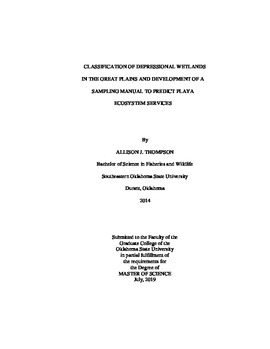| dc.description.abstract | Most depressional wetlands in the Great Plains, an area where wetland losses are estimated to be over 50%, exist in highly cultivated landscapes. The depressional wetlands of the Great Plains include prairie-potholes in the Prairie Pothole Region and playas in the High Plains Region. Both prairie-pothole and playa wetlands provide a host of ecosystem services to society, but service provisioning is greatly influenced by land-use practices that occur both in the wetland and in the surrounding watershed. The most common wetland classification system used to group Great Plains wetlands by type often combines wetlands with of functionally different types into a single grouping, thereby hampering efforts to evaluate ecosystem service provisioning. Thus, my objectives were to 1) develop methodologies, and associated keys, that use aerial and/or satellite imagery and other readily available data sources to place pothole and playa wetlands into hydrogeomorphic function focused groupings to facilitate ecosystem-service assessments, 2) develop a process to remotely determine metrics needed to apply preexisting predictive ecosystem-service models in the playa region and rank the models according to ease of use, and 3) develop a sampling manual for playa wetlands that incorporates the playa-specific key and associated models. Using remotely sensed data, I observed the geomorphic setting of 200 randomly selected palustrine wetlands in each of the two regions and developed a hydrogeomorphic classification key specific to each region. The key included 5 Prairie Pothole Region classes with 12 subclasses and 4 High Plains Region classes with 9 subclasses. The predictive playa ecosystem-service models I evaluated included quantified contaminant filtration, contaminant concentration, pesticide residue, sediment depth, floodwater storage, greenhouse-gas flux, soil organic carbon, plant species richness, amphibian species richness, waterfowl abundance, and avian species richness. I ranked each of these ecosystem-service models by ease of use. The ranking of models resulted in the abiotic-service models being identified as the simplest models to apply and biotic service models as the most complex. I then incorporated the playa-specific hydrogeomorphic key, model rankings and application processes into a sampling manual. The sampling manual included the High Plains Region key and instructions for remotely estimating 10 different playa ecosystem services. This manual will facilitate the identification of wetland function and the estimation of ecosystem services derived from playa wetlands. Use of this manual by natural resource managers would provide information regarding changes in playa wetland service provisioning and inform conservation decisions. | |
